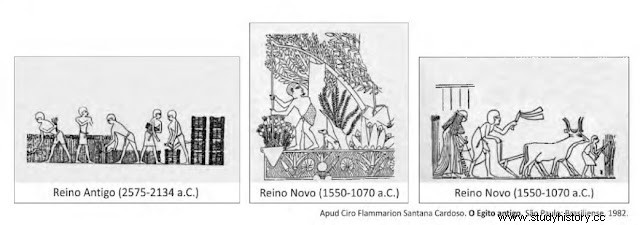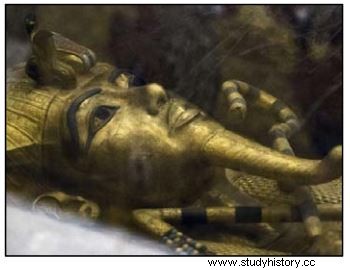
Apud Ciro Flammarion Santana Cardoso. Ancient Egypt. São Paulo:Brasiliense, 1982.
The images reveal
a) the familiar character of agricultural cultivation in the Near East, given the scarcity of labor and the prohibition, in ancient Egypt, of compulsory labor.
b) the inexistence of any technological knowledge that would allow the improvement of food production, which caused long periods of hunger.
c) the prevalence of agriculture as the only economic activity, given the impossibility of hunting or fishing in the regions occupied by ancient Egypt.
d) the difficulty of access to water throughout Egypt, which limited planting activities and made it impossible to raise larger cattle.
e) the importance of agricultural activities in ancient Egypt, which occupied workers for approximately half the year.
Question 02 - UFPel - PAVE 2015 - Step 1 - About the political organization of Ancient Egypt it is correct to say that
(a) the pharaoh occupied the top of the social hierarchy and his system of government was secular.
(b) the pharaoh occupied the top of the hierarchy social and its system of government was theocratic.
(c) the scribes occupied the top of the social hierarchy and their government was shared with priests and nobles.
(d) the pharaoh occupied the top of the hierarchy and its government was shared with priests and nobles.
(e) the scribes occupied the top of the social hierarchy and their system of government was secular.
Question 03 - UFPE - Regarding religion in ancient Egypt, it can be said that: a) religion dominated all aspects of public and private life in ancient Egypt. Ceremonies were performed by the priests every year, to guarantee the arrival of the flood and, thus, good harvests, which were thanked by the king in solemnities to the deities.
b) religion in ancient Egypt, as in other peoples of the Antiquity, did not have much influence, since these peoples, in order to survive, had to develop a huge discipline at work and lived in constant wars.
c) religion had only influence in the life of the kings' family, who used it as a way of keeping the people subject to his authority.
d) the period known as ancient Egypt is the only one in which religion was almost entirely forgotten, and the king as well as the people devoted themselves much more to following the tradition of their ancestors, considered the only atheist peoples of antiquity.
e) the religion of the people in ancient Egypt was quite different from that of the king, due to the superstitious character that the poorer strata of ancient societies had, mainly because of not having access to school and other knowledge only allowed to the royal family.
Question 04 - UFPE - Regarding the art of Ancient Egypt, tick the correct alternative.
a) It aimed at the individual appreciation of the artist.
b) It manifested aesthetic ideas with representations of nature, avoiding the representation of the human figure.
br />c) It was destined to the glorification of the pharaoh and the representation of life beyond the grave.
d) It used hieroglyphics as ornamentation.
e) It was an abstract art that was difficult to interpret.
>
Question 05 - UTFPR 2013-1 - Summer - Regarding the economy of Ancient Egypt, it is correct to say that:A) maritime trade was very developed due to its proximity to the Mediterranean Sea.
B) the trade in Egyptian manufactures supplied other peoples of the Mediterranean Sea.
C) agriculture was largely dependent on the flooding of the Nile River.
D) cattle ranching and mining were the most important economic sectors.
E) agriculture, mining and handicrafts had the same economic importance.
Question 06 - FATEC - 2017/2 - In the 5th century BC, Herodotus, a Greek historian, stated that “Egypt is a gift from the Nile”. Mark the alternative that correctly presents the main reason for attributing such great importance to the development of Ancient Egypt to the Nile River.
(A) In times of flood, the waters of this river fertilized the banks, which made agriculture possible.
(B) The pharaohs built dams to obtain electricity, increasing the production of export items.
(C) Navigation on the great river allowed the Egyptians to conquer southern Europe, forming a great empire.
(D) The clay used to build the great pyramids was removed from the banks of the river.
(E) Crossing Africa from north to south, the Nile made it possible the cultural and economic integration of the area between the Sahara and the Namibian desert.
Question 07 -UFRN - Religion was present in all aspects of life in Ancient Egypt. Medicine was even impregnated with magical and religious elements. The relationship between religion and medicine in Ancient Egypt was evident to the extent that
a) medical practices were aimed only at treating the pharaohs, whose image was associated with the gods.
b) the techniques developed in medicine were stimulated by the need to preserve the body for the afterlife.
c) doctors, recruited from the highest social strata, also accumulated the function of promoting religious worship.
d) doctors wanted to prolong earthly existence, stimulated by religious beliefs that denied the immortality of the soul.
Question 08 - City Hall of Betim - MG - 2015 - Professor PII - Art
Architecture in the Third Dynasty of Ancient Egypt civilization is marked by the transition from baked adobe to stone, thus enabling monumentality and the realization of the notion of eternity linked to the pharaoh. We have at that time Imhotep as the first architect/builder/sculptor to be registered, being also the first to apply carved stone with functional and expressive objectives. His first work was commissioned by Pharaoh Djoser and consisted of mastabas stacked in such a way as to suggest an ascent to heaven. The Egyptian work by Imhotep referred to in the text above is a(a)
A) sphinx.
B) statue.
C) pyramid.
D) temple.
D) temple.
B) statue.
C) pyramid.
D) temple.
br />
Question 09 - IDECAN - 2016 - SEARH - RN - History Teacher
Tomb of Tutankhamun, in the Valley of the Kings, in Luxor (Egypt), which is being investigated

The Egyptian Minister of Antiquities, Mamduh al Damati, pointed out this Tuesday (29) the possibility of a new archaeological discovery in the tomb of the pharaoh Tutankhamun, who inspected these days with the British analyst Nicolas Reeves. This preliminary inspection of the crypt of the so-called “boy pharaoh” is the first step towards proving the veracity of Reeves' theory, who in August revealed that this burial chamber could also contain the tomb of Queen Nefertiti.
(Available at:http
For the Egyptians Pharaoh had undisputed power. He was responsible for agriculture, justice and the administration of the Empire. Ancient Egypt therefore had a government of character:
A) Autocratic and theocratic, as the pharaoh was considered the earthly incarnation of a god and exercised power through authoritarianism and tyranny.
B) Aristocratic and bureaucratic, since it was the upper social class that ruled, in the case of Egypt, through the distribution of land, work and production.
C) Tyrannical and meritocratic, because despite the unlimited extension of the Pharaoh's power, hierarchical positions were conquered, in theory, on the basis of merit.
D) Oligarchic and plutocratic, as it is a system in which power was concentrated in the hands of the holders of society's sources of wealth, in the case of Egypt, the agriculture.
Question 10 - EsFCEx - 2011 - EsFCEx - Student - EsFCEx - Teaching History -
About Ancient Egypt, analyze the statements below and mark the correct answer.
I. Even in the period known as prehistory, Egypt already had a developed civilization.
II. Archaeological finds in the Nile Valley show that agriculture existed even before the 6th millennium BC
III. Archaeological findings indicate that at the end of the 4th millennium BC. C there was already a social stratification that gave rise to the Egyptian state.
(A) only I is correct
(B) only II is correct
(C) only III is correct
(D) only I and II are correct
(E) only II and III are correct
FEEDBACK
01 - E
02- B
03 - A
04 - C
05 - C
06 - A
07 - B
08 - C
09 - A
10 - C
